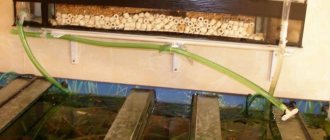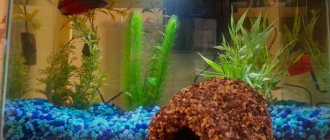How does a soil cleaner work: principle of operation
The principle of operation of the siphon is quite simple and it works from natural gravity.
The tube is inserted into the contaminated soil and held until the area is completely cleaned, and from the other end there is a flow of air, which cleans the aquarium. Water and all ground debris are drained into a reservoir, most often a bucket (in the case of a mechanical siphon) or purified water flows through a filter into the aquarium (in the case of an electric siphon). The speed of water downloading is affected by the diameter of the tube; the larger it is, the faster the water will flow. In simple terms, a siphon is a regular pump. In general, it is a device for pumping out liquid. For example, water will be pumped out of an aquarium along with fish waste.
The main part of the tool is presented in the form of a suction tube. The principle of operation of a siphon for aquariums is very simple: one end of the tube is lowered tightly to the ground, and the second is placed as low as possible in relation to the level of the bottom of the aquarium. The outer tip is dipped into a jar or bucket. It is necessary to create a vacuum in the pipe, but this is a fairly simple procedure, similar to pumping gasoline out of a car using a rubber hose. Vacuum is created by sucking air through the mouth. Similar manipulations are carried out to launch a siphon in an aquarium.
The siphon makes cleaning the soil in the aquarium much easier
The liquid along with the waste will flow by gravity into the pipe and drain into a pre-prepared container. As a result, you need to wait until the dirt settles and drain the water back into the aquarium. The process is not particularly difficult. The auxiliary devices of commercial siphons for cleaning aquariums can be considered the result of scientific developments.
Cleaning and storing the siphon
The homemade device is extremely easy to maintain and clean. After finishing cleaning, it should be disassembled and all parts washed in clean running water. If desired, you can use soapy water to clean the funnel. After that, the funnel should be thoroughly washed with clean water and wiped with a dry cloth.
Important! Any detergent will be harmful to aquarium inhabitants, so be sure to carefully remove all traces of soap or detergents after washing equipment.
As necessary - when indelible stains of dirt, deposits appear, or the hose becomes clogged - the components need to be replaced or a new, clean siphon made.
How does a soil cleaner work: principle of operation
You can make a soil cleaner for an aquarium with your own hands from scrap materials that you probably have in any home. To create a purifier you will need:
- meter hoses (its diameter is no more than 5 mm);
- plastic bottle;
- 2 syringes for 10 cubes;
- insulating tape;
- brass hose outlet;
- knife.
A device for cleaning the soil in an aquarium can be made from scrap materials.
You need to remove the pistons from the syringes and remove the needles. Using a knife, cut off all the protrusions from one syringe to create a tube. From the second, remove the part into which the piston fits with a knife. Make a hole with a diameter of 5 mm in the place where the needle is attached. Connect the resulting tubes together using insulating tape.
A DIY siphon is very easy to maintain and clean. Upon completion of cleaning the aquarium, you need to disassemble all parts and rinse thoroughly under running water. If desired, you can use a soapy solution to wipe down the funnel. After this, you need to rinse it well and dry it thoroughly with a cloth. It should be noted that all detergents can harm fish, so you need to thoroughly rinse all parts of the structure.
As needed, for example, when dirty stains are no longer washed off or deposits clog the hose, you can replace it or make a new design. Cleaning the soil in an aquarium using a siphon is a very important procedure that does not take much time and effort. To clean a structure with a capacity of 50 liters, 10-15 minutes are enough. The benefits of such a homemade device are invaluable.
There are two types of siphons - electric and mechanical. And each has advantages and disadvantages.
Mechanical
These are ordinary devices with a simple design, consisting of a hose, a bulb for drawing in water and a reservoir. Mechanical siphons are preferred due to their ease of operation.
Typically, these devices are made of plastic, most often transparent, in order to control the cleaning process and ensure safety in the event that foreign objects or even the inhabitants of the aquarium themselves get into the tube.
The main disadvantage of a mechanical siphon is the need to drain waste water. While cleaning is taking place, you should monitor the volume of collected liquid, which should not exceed 30%. The drained water can be settled and poured back into the aquarium. The advantages of this type of siphons include its low cost, approximately 150-200 rubles.
We invite you to familiarize yourself with: Aquaterrarium for a turtle
Electric
Electric siphons, unlike mechanical siphons, do not have a hose or reservoir, and the collected water, being purified, is returned back to the aquarium. Such a siphon will consist of a funnel and a motor, and the main advantage is that it saves space and is easy to clean. The downside of the device is the ability to suck in small fish.
If there are many fry in the aquarium, you should choose an electric siphon equipped with a mesh. It prevents small pebbles and fish from being sucked in. The device can operate on batteries or from the mains. Battery-powered siphons have a depth limit of half a meter; if this requirement is not met, water may get into the battery and the device will break. Siphons that operate from the network do not have such a limitation, but their choice depends on how far away the outlet is.
The cost of an electric siphon ranges from 400 to 1000 rubles, depending on the manufacturer.
You can make an aquarium siphon yourself. The main advantage of this method is financial savings.
To make a siphon you will need:
- empty plastic bottle with cap;
- hose (the length of the hose will depend on the volume of the aquarium);
- knife;
- silicone (if sealing is required).
First, cut the bottle in half, using the neck of the bottle as a funnel. Then a hole should be made in the plastic bottle cap, which should coincide with the hole in the hose. The hose should be inserted from the inside.
In the middle of the funnel you should leave no more than two centimeters of the total length of the hose, and the remaining length of the hose should be outside. If you cannot make a suitable hole, you can use silicone to seal it. Sealing is necessary to prevent water leakage. When the silicone dries, you can start using the siphon.
DIY aquarium pump
It must be said that the functions of this pump are not limited to mechanical distillation of water. In particular, its work helps maintain uniform temperature throughout the entire water column.
By supplying water to the filtration system, it is also useful in cleaning the aquarium.
Finally, a water pump can also have decorative functions: it depends on the imagination of the aquarist whether it will be a decoration of the aquarium design, whether the bubbles it erupts will form a fountain or a waterfall.
From the point of view of its location relative to the aquarium, the water pump can be submersible (deep) and external (external); For a modest-sized aquarium, the second option is better. It is clear that each option will have its own fastening, but the way it is fastened does not affect the power of the water pump at all.
You can make a water pump for an aquarium yourself. For example, to make a simple external pump, you will need a plastic box as a base: on its lower surface you need to make two holes for the hose, and on the lid - a larger hole into which a thin rubber membrane will fit.
By gluing silicone petals into the holes made at the bottom of the box, you can use a crank to connect the membrane to a small motor (for example, from a toy car), which will then be connected to a power source. Once all this is completed, a hose is connected to the assembled structure. The water pump for the aquarium is ready.
WomanAdvice.ru
How to make an external filter for an aquarium
Every aquarium should have a filtration system that will purify the water, ensuring the health of the fish and plants. As you know, the waste that the inhabitants of a reservoir leave behind, as well as food residues and suspended soil particles are very harmful to fish.
Uneaten food oxidizes, turning into toxic ammonia. To ensure that the water undergoes all stages of purification in a timely manner, it is better to make an external filter for the aquarium with your own hands. It will prevent the appearance of harmful substances that can poison living beings.
AkvariumnyeRybki.ru
Installing a pump in an aquarium
Depending on where the pump is located in the aquarium, its functions may be different. Pumps differ from each other in the installation method and come in three types:
- internal;
- external;
- universal.
The internal pump is installed in the aquarium and can only be used while immersed in water, while external pumps are attached outside the water container.
But most often pumps are made universal; they can be installed both inside and outside a water container.
To secure the pump both inside and outside, various devices are used, for example, suction cups, special clamps, and so on.
How to choose a pump for an aquarium?
To choose the right pump, you must first of all know the volume of the aquarium, and also decide what the pump will be used for.
If it is used to supply water to an aquarium and to create a flow in a small container, then a low-power pump will be sufficient. But for an aquarium with a volume of more than 250 liters, a more powerful pump is needed.
There are pumps that are designed for both freshwater and marine aquariums.
And there are pumps that are used only in one specific type of aquarium. Therefore, when purchasing a pump, you should check its type, for which aquarium it is needed, as well as the manufacturer of the pump. Some Russian pumps are in no way inferior to foreign ones in terms of workmanship and durability.
When buying a pump for an aquarium, you should not save money, because the pump is one of the main life support systems for aquarium inhabitants.
The main line produced by the company is Eheim Universal, Eheim Compact and Eheim Compact +. Most of the Eheim models are attached using suction cups and are considered universal, as they can be attached both in the aquarium and on its outer wall. Their productivity is from 270 to 2280 l/hour.
You can buy a submersible pump for an aquarium for either 1,000 rubles (with a capacity of 120-380 l/hour) or for 14,000 rubles with a capacity (2,400 l/hour).
Features of Eheim pumps include: Small size; Suction cup mount; Possibility of complete immersion in water; Pump power adjustment; Can be used in both salt and fresh water;
Protecting the inhabitants of the aquarium using a protector (fence grid); Stylish appearance; Built-in multifunctional filters.
It is with the help of such powerful systems that talented designers create a huge underwater kingdom, where air bubbles “draw” bizarre shapes.
For small aquariums where there is no need for expensive and powerful pumps, cheaper pumps can be used.
Devices under the Hailea brand are ubiquitous. Each aquarium pump from this brand is equipped with a water flow regulator, an innovative drain valve and a rubber suction cup. Compared to expensive models from Eheim, they are less attractive in appearance, but at the same time, pumps of this brand successfully cope with their work, which is why they are actively being purchased by people.
You can buy a water pump for an aquarium from this manufacturer for 400-500 rubles, with a capacity of 180 l/hour. If you need the most powerful device, for 6,000 rubles you can purchase a device with a capacity of 7,800 l/hour. Models of the Aquael brand are also known.
This is another representative of the budget class - prices for devices start around 300 rubles. For this amount you can purchase the Aquael Circulator 350 model, capable of pumping up to 350 liters per hour, with a power of only 4.5 W.
This is the “weakest” model - the manufacturer’s range includes devices labeled as Aquael Circulator 500, 650, 1000, 1500, 2000 and 2600. The number in the label, of course, indicates performance.
Such a device costs only 300 rubles - one of the minimum indicators in its segment. For just 600 rubles, this brand offers to buy a device with a capacity of 1380 liters.
The most powerful option is 12,000 l/h: Resun Eco-Power EP-12000. Such a device costs around 6,000 rubles.
One of the obvious shortcomings of this brand of equipment is the lack of a regulator - which is not very convenient.
aquarium-fish-home.ru
DIY aquarium compressor
How to make an aquarium compressor yourself? oxygen for fish. with your own hands
homemade compressor for aquarium
DIY aquarium water drainage system
homemade compressor for aquarium
Other articles
Source: https://akva-rybka.ru/akvarium/nasos-dlja-akvariuma-svoimi-rukami.html
Types of siphons
Today there are many different types and models of siphons on the shelves of specialty stores. Their operating principle is identical, the difference is in the types of drive, power supply and the availability of additional options. Depending on the type of drive, the devices are:
- Electrical. In addition to the standard components in the form of a tube and a glass, this device has a pump that operates from the mains or using batteries. It is with the help of the pump that the waste is collected. All waste goes into a special pocket, and clean liquid is returned back to the aquarium. The device is convenient to use, does not harm plant roots, and has high power. However, there are a number of disadvantages: the device is fragile, requires frequent replacement of batteries, and is expensive.
The electric siphon has a pump for collecting debris from the ground
- The mechanical device operates by gravity. It contains a funnel, a hose and a glass. The pressure depends on the width of the hoses and funnel - the narrower they are, the greater the force with which the liquid is suctioned. Many models are equipped with bulbs, with the help of which pumping begins. This siphon is quite easy to use, does not require special skills, is suitable for processing any aquarium, and is accessible to everyone. The disadvantages include the impossibility of adjusting the power of liquid flow and the difficulty of working in places where algae accumulate. In addition, an auxiliary water collection tank is required for subsequent filtration.
Mechanical siphon suitable for all aquariums
Advantages and disadvantages of a homemade vacuum cleaner
A homemade siphon has a number of advantages :
- It is easy and quick to make; it does not require additional skills or knowledge;
- The cost of the materials used is low, which makes it profitable;
- In terms of the degree of soil purification, it is not much inferior to its store-bought counterpart.
However, in addition to advantages, homemade siphons also have disadvantages :
- The device must be used carefully and carefully, since the pointed tip can easily damage plant roots;
- If there are small crustaceans or fish in the aquarium, the use of a siphon must either be abandoned or equipped with a special mesh at the tip;
- Small pebbles or large grains of sand simply easily fall into the tube, blocking the flow of water;
- With constant operation of the device, the process of natural filtration is significantly reduced. Components located in the lower layers of the soil and necessary for the development and growth of flora may also be washed away;
Instructions for use
So, after the siphon is ready, you can check it in action. Cleaning must be carried out at least once every 30 days. During this period of time, food residues, fish waste, and dead plants will have time to accumulate at the bottom of the aquarium.
In order for a do-it-yourself aquarium siphon to work, you need to immerse the funnel in the aquarium, and lower the other end into a pre-prepared container to collect dirty liquid. You can run the cleaner using several methods:
- Use your mouth to draw the liquid through the hose, and then it will flow into the container on its own.
- Submerge the funnel completely into the aquarium, closing the drain hole, then lower it into the container, and the liquid will flow on its own.
We invite you to read: Calf dyspepsia: description, treatment and prevention
A homemade cleaner can be launched either with your mouth or with a pear
- You can resort to using a medical bulb. To do this, you need to pump air into it several times from the drain, and water will begin to flow at the return.
You need to start cleaning from places that are free from plants. First you need to place the funnel in the ground and rock it so that the dirt rises from the very bottom. Heavy soil will sink back, and light soil will flow out along with the water.
Structure and principle of operation
A siphon for aquariums, acting like a dropper, is a long transparent hose, to which a wider tube is attached at one end, and at the other - a traction device (similar to a vacuum cleaner) with the ability to drain contaminated liquid. The first part is a glass, a cylindrical funnel (with a diameter of at least 5 cm) or any other suction or receiving device. The second is a special pump, a bulb, or simply the open end of a tube, through which you can independently provoke the outflow of air from the system by inhaling.
Which one is better to choose and what to pay attention to?
When choosing, you should take into account the parameters of the aquarium and the number of inhabitants in it, and ease of use plays an important role. You can give preference to electric siphons, which are easy to use, or mechanical ones, which are very easy to use and understanding the instructions will not be a problem.
The diameter of the hose plays an important role. It should be slightly larger than the diameter of the pebbles in the aquarium. Choose a transparent hose; this will protect the siphon from blockages, because you can easily control the cleaning process. Preference should be given to plastic hoses, which are lightweight and elastic.
Be sure to select a siphon taking into account the volume of the aquarium. For a small volume, a small siphon is suitable so as not to suck in small fish and pebbles. And for a large one, it is advisable to have a more massive siphon (a small one may simply not cope with a lot of work).- If the diameter of the hose is large, then the water flow will be stronger, and in the case of a nano aquarium, you may not have time to siphon all the soil, since the water from the aquarium will drain faster.
- There are also differences in the attachments of aquarium siphons. It is better to use nozzles of different sizes. The large ones are suitable for cleaning the middle of the aquarium, and the small triangular ones are suitable for processing decorations and corners.
Is it possible to make an electric vacuum cleaner to clean the soil of an aquarium?
Designing a homemade electric siphon is not much more difficult than its mechanical counterpart. However, skills in working with power tools, a soldering iron, and knowledge of safety rules are required . The essence of this design is to mount a small hydraulic pump, bag-shaped filter or tube into one system.
It is better to abandon such an undertaking if you do not have basic skills in circuit design, since the siphon will be used in close proximity to water. In addition, the electric siphon is much more difficult to turn off in time. This creates an additional danger for the flora and fauna of the aquarium.
If you decide to make an electric siphon, then check out this video. This video will tell you how to make an electric siphon with your own hands:
Top best manufacturers
There are a large number of mechanical and electrical soil cleaners for aquariums on the market today. The most popular and sought-after manufacturers: Aquael, Tetra, JBL and Sera. They produce high quality siphons and there are a large number of different models of mechanical and electronic siphons on the market with their own advantages.
Aquael
Aquael is a Polish company, a manufacturer of the highest quality products, specializing in the production of various accessories for aquariums, including fish food, filters and aquarium siphons. The company is one of the leaders in the production of aquariums.
Aquael siphons are multifunctional devices that, in addition to cleaning the soil, also clean the glass of the aquarium. The siphon itself consists of a cylinder made of transparent plastic and a hose that is resistant to bending. The products are equipped with a mesh to prevent the absorption of foreign bodies. The cost ranges from 500 to 1000 rubles.
Tetra is a world-famous company offering a wide range of products for aquariums. Siphons from this company are easy to use, as they have simultaneous drainage of water, a powerful valve, a protective mesh and other devices for more convenient use. The product from this company can be used to completely pump out water from an aquarium.
The advantage of these siphons is their high quality and long service life. The price will depend on the siphon model and varies from 200 to 900 rubles.
We suggest you read: Marine Aquarium – Aquarist’s Blog
JBL is a German company that develops products for aquariums, terrariums and garden ponds. It is a well-known manufacturer with high quality standards.
Siphons from this manufacturer are distinguished by the presence of adjustable suction force. Also available are manual siphons with a check valve and a quick stop button to instantly stop the water supply.
The quality of the products is high, so they will last a very long time. The price for mechanical siphons is from 300 rubles, for electronic ones from 500 rubles.
Sera is another German company worthy of mention as one of the best aquarium product companies. It has been a leader in the market for more than 30 years. Produces products for aquariums and ponds of the highest quality. Their siphons have an unusual round shape, which is most suitable for aquariums with a large area.
The cleaner is made of high-quality transparent plastic, which helps to avoid the absorption of plants and fry. The material is non-toxic to fish, so there is no need to worry about its safety. The cost of Sera siphons is about 600 rubles.
Review of professional equipment
Today, manufacturers of equipment for aquarium maintenance offer a large selection of siphons for cleaning soil of various types: cheap and expensive, mechanical, electrical, of various capacities, with sedimentation tanks and special valves. It is difficult to decide, at first glance, which device to give preference to.
- EHEIM. If the aquarium owner prefers high-tech systems, then he will like the famous German products. The battery-powered electric device weighs 630 g. Despite its light weight, it effectively cleans the aquarium without draining the liquid. He immediately returns the purified water. The suction tube has serrated perforated edges. This is necessary in order to preserve the roots of the plants. This device is designed for containers up to 200 liters, the height of which is no more than 50 cm. The disadvantages of the device include the high cost and rapid discharge of the batteries. The last problem can be solved by installing an adapter so that the power comes from the electrical networks.
Electric siphon from the German company EHEIM is lightweight and efficient
- HAGEN is a company from Germany that is a leader in the production of cleaning siphons. The company has an extensive line of its products, the prices of which are not affordable for everyone. The electric device Hagen Marina Aqua Vac carefully and efficiently cleans the soil at the bottom, and also allows you to change the water using a 7-meter hose included with the device. The cost of this device is very high and amounts to about 6 thousand rubles. If purchasing a device is too expensive, you can buy a compact device from this company, which can be launched using a rubber bulb. In addition, to collect liquid you will need a container that needs to be installed below the aquarium. The cost of such a device is no more than 600 rubles.
- The Tetra company produces siphons of different capacities. Cost varies, but in general these cleaners are budget-friendly and high quality.
- AQUAEL. Many experts praise this Polish company. It creates lightweight and effective siphons for the soil in the aquarium. This company has been competing with German companies for a long time. Their big advantage is the low cost of production.
The choice of manufacturer depends on the budget and preferences of the buyer. Cleaning an aquarium is an important procedure for maintaining normal living conditions for its inhabitants. You can buy a special siphon ready-made or make it yourself and save a lot of money.
Why is the soil cleaned?
During the operation of the aquarium, the soil at its bottom slowly but surely becomes clogged with debris settling on it - uneaten fish food, waste products of the inhabitants of the aquarium, silt, etc.
This process should never be ignored, since the contaminated soil very quickly begins to sour , which, in turn, will lead to the saturation of the water with ammonia and toxic nitrites. As a result of the latter, aquarium fish may be poisoned and die.
This is why it is so important to acquire a device for cleaning the soil - a siphon, or soil cleaner, for an aquarium). The process of such cleaning is appropriately called siphoning. To control the need to siphon the soil, you should periodically check it, carefully loosening it with a stick - if this causes turbidity to rise, it’s time for cleaning.
It is rare to produce clean aquariums that are completely planted. The point is not only the danger of gross interference in its ecosystem, but also the fact that the soil in such domestic “reservoirs” rarely turns sour. The reason for this is the fact that plant roots passing through all layers of soil emit oxygen. It, in turn, excludes the formation of so-called anaerobic zones.
It is forbidden to siphon a newly equipped aquarium. You must first wait until a colony of special nitrifying bacteria grows in it. This usually happens within a couple of weeks.
Aquarium soil










